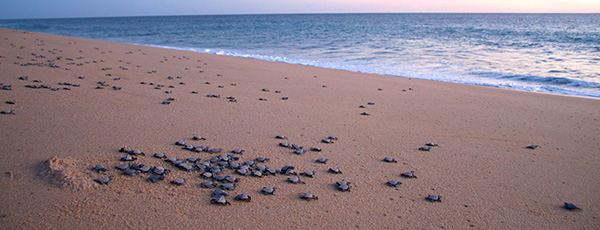
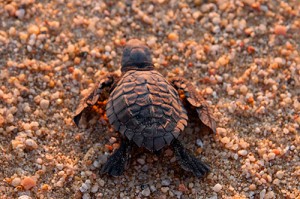
Sometimes it’s hard to believe how much cuteness can fit in the palm of your hand. Or how much fun you can have digging in the sand – especially when you’re helping to rescue and release baby sea turtles. This season, we’ve been organizing regular excursions for guests to get elbow deep in the sand, helping local researchers and preservationists to clean sea turtle nests – and giving the baby turtles a helping hand on their journey to their new home in the ocean. It’s an inspiring way to see the natural cycle up close, to learn about the turtles and their habitat, and to assist those who are making a real difference in sea turtle survival rates.
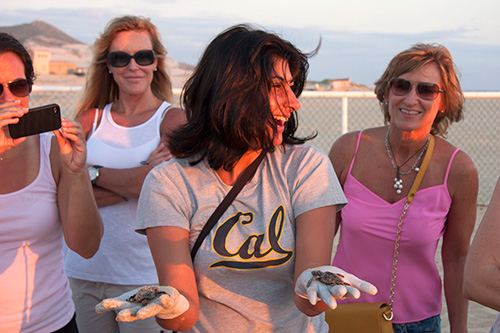
Local non-profit preservation group Asupmatoma works tirelessly to patrol Pacific beaches, relocate sea turtle nests to safe areas to ensure the highest yield among the eggs, assist the baby turtles as they hatch, and educate the public about these special creatures and the threats to their habitat. There are three primary turtle species that nest on the beaches near Prana del Mar – Olive Ridley, Leatherback, and Green turtles – with the Olive Ridleys (know as golfinas in Spanish) being the vast majority. All of these varieties are currently endangered, though conservation efforts have been fruitful in helping the populations to recuperate. By involving locals and visitors of all ages, Asupmatoma is raising awareness both in the local Los Cabos area and abroad – and creating special memories for people that will last a lifetime.
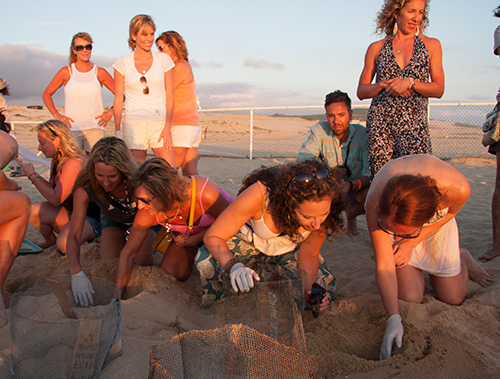
Each evening during nesting season, the biologists and volunteers from Asupmatoma scour the beach for the telltale signs of new turtle nests. They then carefully extract the eggs from their original locations and move them to a protected corral on the beach where they rebury them in the sand – taking care to create optimal conditions for maximum yield – to ensure their safety during the 45-day incubation period. It’s important to accurately replicate the conditions of a natural nest and to place them at a spot on the beach where the ambient temperature under the sand is in the low-80s (about 27° C). If the temperature is too high, then the majority of the hatchlings will be female; if the temp is too low, then the majority will be male. In the wild, anywhere from 10% to 50% of the eggs will hatch, depending upon conditions. At our local hatchery, over 80% of the eggs hatch with viable baby sea turtles.
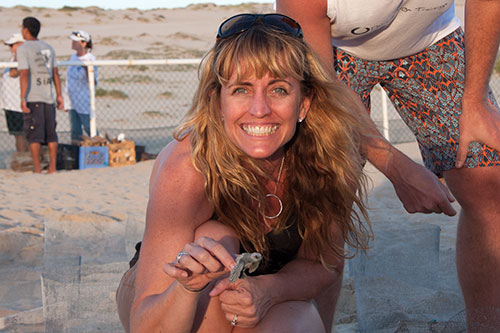
As volunteers, we are lucky enough to assist the biologists in cleaning the nests to make sure none of the young turtles is left behind, digging down deep in the sand until we have removed all of the hatchlings, the remnants of their eggshells, and any infertile eggs. In nature, some of the last turtles to hatch often get buried under the weight of the sand as it compacts around them after their siblings have dug themselves out of the nest. So visitors are doing real rescue work as they clean the nest to make sure all survivors get the chance to make it to the ocean. The baby turtles often emerge from the nest a little groggy at first, but once they feel the sun on their shells and hear the ocean, they get pretty animated and their little flippers start propelling them around the small holding pen. An accurate count is made for the scientific records, and then we’re off to the shoreline to let them scamper free toward the next phase of their journey.
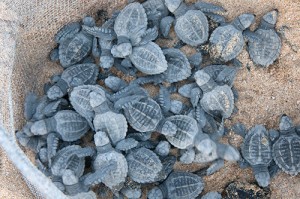
As the sun sinks low on the horizon, dipping into the Pacific, we spread the newly-hatched turtles along the sand about 30 feet from the water’s edge. Their instincts are strong and they immediately begin to scamper toward the water – several eager ones make a beeline directly for the surf and others who are still getting used to life outside the nest amble at a more moderate pace. It’s exciting to watch them paddle their flippers over the sand and inch their way towards the water, with the foam of each successive wave getting closer and closer to carrying them off into the Pacific. Though short, this journey across the beach is important. The turtles have subtle sensors on the undersides of their shells that imprints upon the texture of the beach. When the females become adults and are ready to create nests of their own, they will return to the same beach upon which they hatched some 15-20 years earlier – and will continued to come back each year to nest. Those 10 minutes of scuttling across the beach of their birth will stay with them for a lifetime – potentially 100 years or more – just as it has for the generations that preceded them.
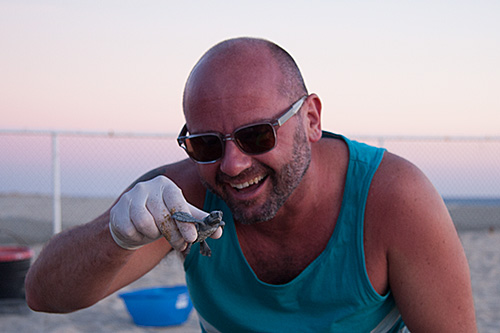
It feels satisfying and humbling to witness such an important part of this cycle of regeneration and to realize that the same turtles released here throughout this season will continue to return for decades. One day, in fact, our great-grandchildren could visit this same coastline and witness the hatching of one of their future nests. With any luck – combined with the hard work and dedication of the biologists and volunteers of organizations like Asupmatoma – perhaps by then, they will no longer need a helping hand from us.
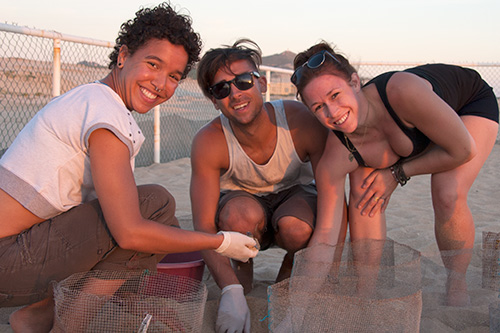
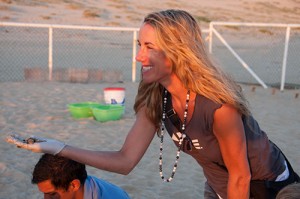
![]()
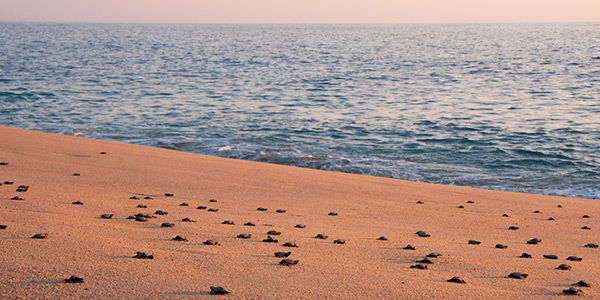

I looooove this! Thank you for the update!
Excited for you to come see them – they’re pretty adorable.
This seems absolutely wrong. Baby sea turtles get one boost of energy to run into the ocean by instinct and you people are digging up the nests and putting them in a bucket and allowing people to play with them. This is when they should be running into the ocean. I’m sure you all are charging guests a hefty fee to do this as well!!!!!!! Absolutely terrible!!!!!!
Thank you for your concern for the sea turtles, Amanda. The conservation efforts of the non-profit environmental group that protects the turtles in our area is called Asupmatoma. It is staffed by marine biologists and trained volunteers who do an exceptional job of protecting the various species native to Los Cabos and their nesting grounds. I’m certain that if you do your own research into their efforts, you’ll come to understand how beneficial their work is to the preservation of these precious animals. You can find out more information on their website: http://asupmatoma.org/ (in Spanish). For information in English, you can check their Facebook page (https://www.facebook.com/Asupmatoma) or a summary on a local web directory (http://www.mexonline.com/tortuga.htm). With some research, I hope you will better understand the great service that this organization is offering in the effort to help these turtles thrive.
With regard to handling of the hatchlings, the only nests that guests are allowed to dig up is ones where the majority of the baby turtles have already crawled out under their own power. In many cases, some of the turtles hatching from the eggs at the bottom of the nest are unable to crawl out due to the weight of the sand that collapses in on them as their brethren climb out of the nest. In the wild, these baby turtles die in the nest. Due to Asupmatoma’s efforts, the yield of living hatchlings that make it to the sea is approximately 90%, which is a significant improvement over the 50-60% percent that make it from nests in the wild.
As far as fees, we do not charge our guests anything for organizing this excursion. We arrange for transport and our guests pay that cost directly to the transportation company. Asupmatoma requests a nominal donation of US$10 per person to assist with their substantial overhead costs, though many visitors are so inspired by their experience that they choose to offer more. Again, these offerings go directly to the non-profit organization and help to fund their ongoing operations.
We appreciate that you are passionate about protecting the turtles and encourage you to continue advocating for the turtles in a positive and productive manner.